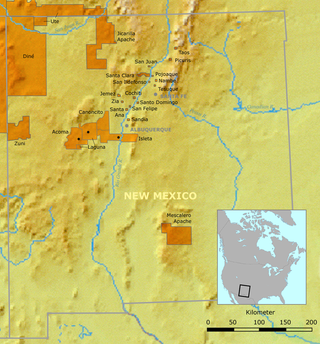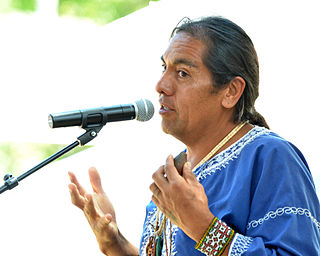Meeting with Carl Jung
In December 1925, Mirabal was introduced to C. G. Jung by de Angulo. In writings describing their meetings, Jung referred to Maribal using what he believed to be his Tiwa Language name (Ochwiay Biano) and its approximate English translation (Mountain Lake), though some scholarship has cast doubt on the accuracy of both names.
In his book Memories, Dreams, Reflections, Jung recalls a conversation he had with Mirabal, which Jung reported as follows:
"How cruel the whites are: their lips are thin, their noses sharp, their faces furrowed and distorted by holes. Their eyes have a staring expression. They are always seeking something. What are they seeking? The whites always want something, they are always uneasy and restless. We do not know what they want, we do not understand them, we think that they are mad." I asked him why he thought the whites were all mad. "They say they think with their heads", he replied.
"Why, of course. What do you think with?" I asked him in surprise.
"We think here", he said, indicating his heart.
Later in Jung's visit, Mirabal taught Jung that his people, like the Elongyi tribe of Kenya, rose in the morning and spit in their palms, thereby presenting their soul-stuff to the sun to welcome it in an expression of sympathetic magic.

The Puebloans, or Pueblo peoples, are Native Americans in the Southwestern United States who share common agricultural, material, and religious practices. Among the currently inhabited Pueblos, Taos, San Ildefonso, Acoma, Zuni, and Hopi are some of the most commonly known. Pueblo people speak languages from four different language families, and each Pueblo is further divided culturally by kinship systems and agricultural practices, although all cultivate varieties of maize.

Taos is a town in Taos County in the north-central region of New Mexico in the Sangre de Cristo Mountains. Initially founded in 1615, it was intermittently occupied until its formal establishment in 1795 by Nuevo México Governor Fernando Chacón to act as fortified plaza and trading outpost for the neighboring Native American Taos Pueblo and Hispano communities, including Ranchos de Taos, Cañon, Taos Canyon, Ranchitos, El Prado, and Arroyo Seco. The town was incorporated in 1934. As of the 2010 census, its population was 5,716.

The Taos art colony was an art colony founded in Taos, New Mexico, by artists attracted by the culture of the Taos Pueblo and northern New Mexico. The history of Hispanic craftsmanship in furniture, tin work, and other mediums also played a role in creating a multicultural tradition of art in the area.

Picuris Pueblo is a historic pueblo in Taos County, New Mexico, United States. It is also a census-designated place (CDP) and a federally recognized tribe of Native American Pueblo people. The 2010 census estimated that 68 people lived in the CDP, while 267 people in the U.S. reported being of the tribal group Picuris alone and 439 reported being of the tribal group Picuris alone or in combination with other groups. Picurís Pueblo is a member of the Eight Northern Pueblos. Their own name for their pueblo is P'įwweltha, meaning "mountain warrior place" or "mountain pass place." They speak the Picuris dialect of the Northern Tiwa language, part of the Kiowa-Tanoan language family.
The Pueblo Revolt of 1680, also known as Popé's Rebellion or Popay's Rebellion, was an uprising of most of the indigenous Pueblo people against the Spanish colonizers in the province of Santa Fe de Nuevo México, larger than present-day New Mexico. The Pueblo Revolt killed 400 Spaniards and drove the remaining 2,000 settlers out of the province. The Spaniards reconquered New Mexico twelve years later.

Santa Fe Indian School (SFIS) is a tribal boarding secondary school in Santa Fe, New Mexico. It is affiliated with the Bureau of Indian Education (BIE).
New Mexico is a state of the Southwest United States. The state has music traditions dating back to the ancient Anasazi and Pueblo people, Navajo, Apache, and the Spanish Santa Fe de Nuevo México; these old traditions are found in both their original folk forms and as a modern folk genre known as New Mexico music.

Robert Mirabal is a Pueblo musician and Native American flute player and maker from Taos Pueblo, New Mexico.

The Battle of Cañada was a popular insurrection against the American occupation of New Mexico by Mexicans and Pueblo Indians. It took place on January 24, 1847, during the Taos Revolt, a conflict of the Mexican–American War.

Pueblo of Isleta is an unincorporated community and Tanoan pueblo in Bernalillo County, New Mexico, United States, originally established in the c. 14th century. The Southern Tiwa name of the pueblo is Shiewhibak (Shee-eh-whíb-bak) meaning "a knife laid on the ground to play whib", a traditional footrace. Its people are a federally recognized tribe.
The Río Arriba Rebellion, also known as the Chimayó Rebellion, was an 1837 Pueblo-Hispano popular revolt in New Mexico which succeeded in briefly placing José María González and Pablo Montoya as governor of Mexico's Santa Fe de Nuevo México territory. González and Montoya were both Taos Pueblo Indians and led the independent Junta Popular or Cantón, which was the most ethnically inclusive government in the history of New Mexico. They remain the only Pueblo governors of New Mexico to this day.

Elsie Worthington Clews Parsons was an American anthropologist, sociologist, folklorist, and feminist who studied Native American tribes—such as the Tewa and Hopi—in Arizona, New Mexico, and Mexico. She helped found The New School. She was associate editor for The Journal of American Folklore (1918–1941), president of the American Folklore Society (1919–1920), president of the American Ethnological Society (1923–1925), and was elected the first female president of the American Anthropological Association (1941) right before her death.

The Taos language of the Northern Tiwa branch of the Tanoan language family is spoken in Taos Pueblo, New Mexico.
The Pueblo linguistic area is a Sprachbund consisting of the languages spoken in and near North American Pueblo locations. There are also many shared cultural practices in this area. For example, these cultures share many ceremonial vocabulary terms meant for prayer or song.

Pop Chalee, also known as Merina Lujan, was an American painter, muralist, performer, and singer. In 2021, she was inducted into the National Cowgirl Museum and Hall of Fame.
Florence Melva Pierce née Miller was an American artist best known for her innovative resin relief paintings. Her work has often been linked with monochrome painting and minimalism.
Eva Mirabal, also known as Eah-Ha-Wa (1920–1968) was a Native American painter, muralist, illustrator, and cartoonist from Taos Pueblo, New Mexico. Her primary medium was gouache, a type of watercolor.
The history of Albuquerque, New Mexico dates back up to 12,000 years, beginning with the presence of Paleo-Indian hunter-gatherers in the region. Gradually, these nomadic people adopted a more settled, agricultural lifestyle and began to build multi-story stone or adobe dwellings now known as pueblos by 750 CE. The Albuquerque area was settled by the Tiwa people beginning around 1250. By the 1500s, there were around 20 Tiwa pueblos along a 60-mile (97 km) stretch of the middle Rio Grande valley. The region was visited by Spanish conquistadores beginning with the expedition of Francisco Vázquez de Coronado in 1540–41, and began to be settled by Spanish colonists after the expedition of Juan de Oñate in 1598. By 1680, 17 Spanish estancias were reported along the Camino Real in the Albuquerque area.

Native American fashion is the design and creation of high-fashion clothing and fashion accessories by Native Americans in the United States. This is a part of a larger movement of Indigenous fashion of the Americas.












